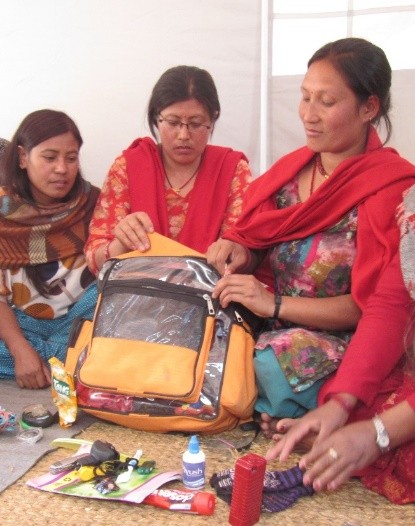
June 2015—When the magnitude 7.8 earthquake struck central Nepal on April 25, Sita Shrestha knew what to do. She found a place near an inner wall of her house to wait out the shaking with her 5-month-old daughter and told her 6-year-old son, who was on a different floor, to do the same. When the shaking stopped, Shrestha grabbed her “go bag”—a disaster preparedness kit—and took her children to a safe, open space in the courtyard.
Using the tarpaulin from the go bag, Shrestha made an emergency shelter for her family. She also used disinfectant from the kit to treat her children’s wounds and passed out medicines to neighbors with headaches and other minor ailments. Additional supplies from the bag, including chlorine to purify water, a head lamp, soap and toothpaste proved invaluable in the days following the earthquake, according to Shrestha, who made use of every item in her kit.
Shrestha attributes her capable response during and after the earthquake to a preparedness course she took in 2013, conducted by USAID partner the National Society for Earthquake Technology (NSET). The training taught Shrestha how to protect herself during an earthquake and the importance of having an emergency kit in her home, which NSET provided to course participants. Shrestha retained the knowledge gained from the training and shared it with her family, but she did not fully realize the value of the go bag until the earthquake struck.
“Since I got training on earthquake preparedness and emergency response … I had told my children and other family members not to panic and not to run inside the home or use the staircase … but stay at the safe place and go outside once the shaking stops,” said Shrestha. “I also learned about the need to store the emergency kit from the training. I knew that the go bag was important and so have kept one myself, but I had not imagined that our go bag could be that useful in this situation.”
The training Shrestha received was a component of the larger USAID-funded Nepal Earthquake Risk Management Project, through which NSET coordinated long-term disaster risk reduction planning and worked with the Government of Nepal, local schools and communities like Shrestha’s to increase earthquake awareness and preparedness. NSET implemented the program in two phases between March 2011 and April 2015, training more than 4,000 people and distributing more than 600 go bags during the second phase. The program focused on Kathmandu Valley and other urban areas of Nepal, including the city of Kathmandu, four submetropolitan cities, 53 municipalities and 135 small towns.
LINKS
Follow @USAIDNepal, on Facebook, on Flickr, on YouTube







Comment
Make a general inquiry or suggest an improvement.